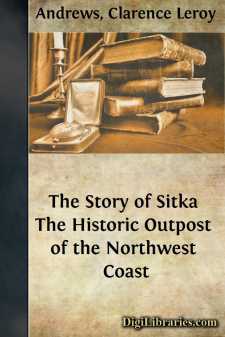Categories
- Antiques & Collectibles 13
- Architecture 36
- Art 48
- Bibles 22
- Biography & Autobiography 813
- Body, Mind & Spirit 142
- Business & Economics 28
- Children's Books 15
- Children's Fiction 12
- Computers 4
- Cooking 94
- Crafts & Hobbies 4
- Drama 346
- Education 46
- Family & Relationships 57
- Fiction 11828
- Games 19
- Gardening 17
- Health & Fitness 34
- History 1377
- House & Home 1
- Humor 147
- Juvenile Fiction 1873
- Juvenile Nonfiction 202
- Language Arts & Disciplines 88
- Law 16
- Literary Collections 686
- Literary Criticism 179
- Mathematics 13
- Medical 41
- Music 40
- Nature 179
- Non-Classifiable 1768
- Performing Arts 7
- Periodicals 1453
- Philosophy 64
- Photography 2
- Poetry 896
- Political Science 203
- Psychology 42
- Reference 154
- Religion 513
- Science 126
- Self-Help 84
- Social Science 81
- Sports & Recreation 34
- Study Aids 3
- Technology & Engineering 59
- Transportation 23
- Travel 463
- True Crime 29
The Story of Sitka The Historic Outpost of the Northwest Coast
Description:
Excerpt
SITKA
Foreword
The panorama of sea, island, and mountain, which holds Sitka, Alaska, as a jewel in its setting, is one of the most beautiful of those which surround the cities of the world. Toward the sea from the peninsula on which Sitka is situated stretches an expanse of waters, studded with forest-clad islands which break the swell of the Pacific that foams and tumbles on the outer barriers. To the westward Mount Edgecumbe lifts its perfect cone, its summit truncated by the old crater whose fires have been dead for centuries; to the northward Harbor peak lifts its signal to mariners; the Sisters, with a gleam of snow and ice among their pinnacles, lie in the distance of Indian River; to the east is the arrowhead of Mount Verstovia; the glaciers glisten beyond; and the sweep of mist-clad mountains, in their softness, beyond the bay to the southeast completes the circle.
Radiating like the spokes of a wheel, waterways with historic memories reach out from the town. Krestof Bay, where the early navigators cast anchor; Neva Strait, commemorating the first Russian ship that visited Sitka from around the world; Katleanski Bay, on which was situated Old Sitka; Silver Bay, a Norwegian fjord transplanted to Alaska; Lisianski Bay, named for the Russian navigator of a century ago; the inlet at Ozerskoe Redoubt and Globokoe (Deep) Lake; the island-studded way to the Hot Springs; each with its individual charm; the ocean, with the deep, rich, marine tints of northern waters; the forest of blue, that folds like a robe over the mountains; the mountain summits beside the glaciers, clad in the exquisitely wonderful green of the Northland, all are delightful. But when the sun sinks low in the west, with the long, lingering twilight of the North, and the soft, delicate rays touch and blend with the water and islands, the mountains and sky–then, in the mystery of the evening, is the supreme beauty of the land. To those who have really known and loved Sitka, there is no place on earth to compare.
There are pleasant recollections of those who have lived there. Jovial Edward Degroff and his stories at the Roastology Club; the Mills, whose hospitable home is known to every resident of the town; Wm. Gouverneur Morris, whose name recalls a leader of Revolutionary days; genial George Barron, who upheld every good tradition of the Navy; the gallant old soldier, Matthew P. Berry; dignified Judge Delaney, Alaska’s staunchest advocate through all vicissitudes; Governor Brady, with his neverfailing faith in Alaska’s greatness; Captain Francis, without whom the early naval commanders thought the warships could not thread the intricate passages; Nicholas Haley, with his optimistic dreams of El Doradoes; Pauline Archangelsky, for whom the “Old Timers” have pleasant recollections; Alonzo Austin and his mission; Captain Kilgore of the “Rush”; Merrill, who caught on the photograph plate the elusive spirit of the varying surroundings as only a true artist could; Katherine Delaney Abrams, whose touch in watercolor delineated the glory of the sunsets as none else could; Professor Richardson, who for a quarter of a century returned year after year thousands of miles to perpetuate in paintings the exquisite tintings of glaciers and mountain; George Kostromitinoff (Father Sergius); Father Metropolski, and many others who have made a part of the quaint old town.
There is a saying that whosoever comes to love the waters of the Indian River will ever after yearn for them, and it seems true, for always is that harking back to its banks with an unsatisfied longing.
From prehistoric time this has been the home of the Sitka Kwan of the Thlingit people. For sixty-three years it was the scene of the chief activities of the Russian American Company, who represented the rule of the Muscovites, who, when Chicago was but a blockhouse in a sedgy swamp on the banks of a sluggish, reedy river, and when San Francisco was but a mission and a Presidio of sun-burned bricks, maintained in Sitka a community of busy people who were casting cannon and bells, and who were building ships for commerce....


